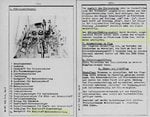davebender
1st Lieutenant
WWII era Mustangs had a reputation for being vulnerable to ground fire. Some A-36s operating in the Med were supposedly replaced with P-40s for that reason.
Strangely enough the USAF employed large numbers of P-51Ds for ground attack during the Korean War. Seems like that wouldn't be the case if the Mustang was already known to be poor for CAS.
Strangely enough the USAF employed large numbers of P-51Ds for ground attack during the Korean War. Seems like that wouldn't be the case if the Mustang was already known to be poor for CAS.


